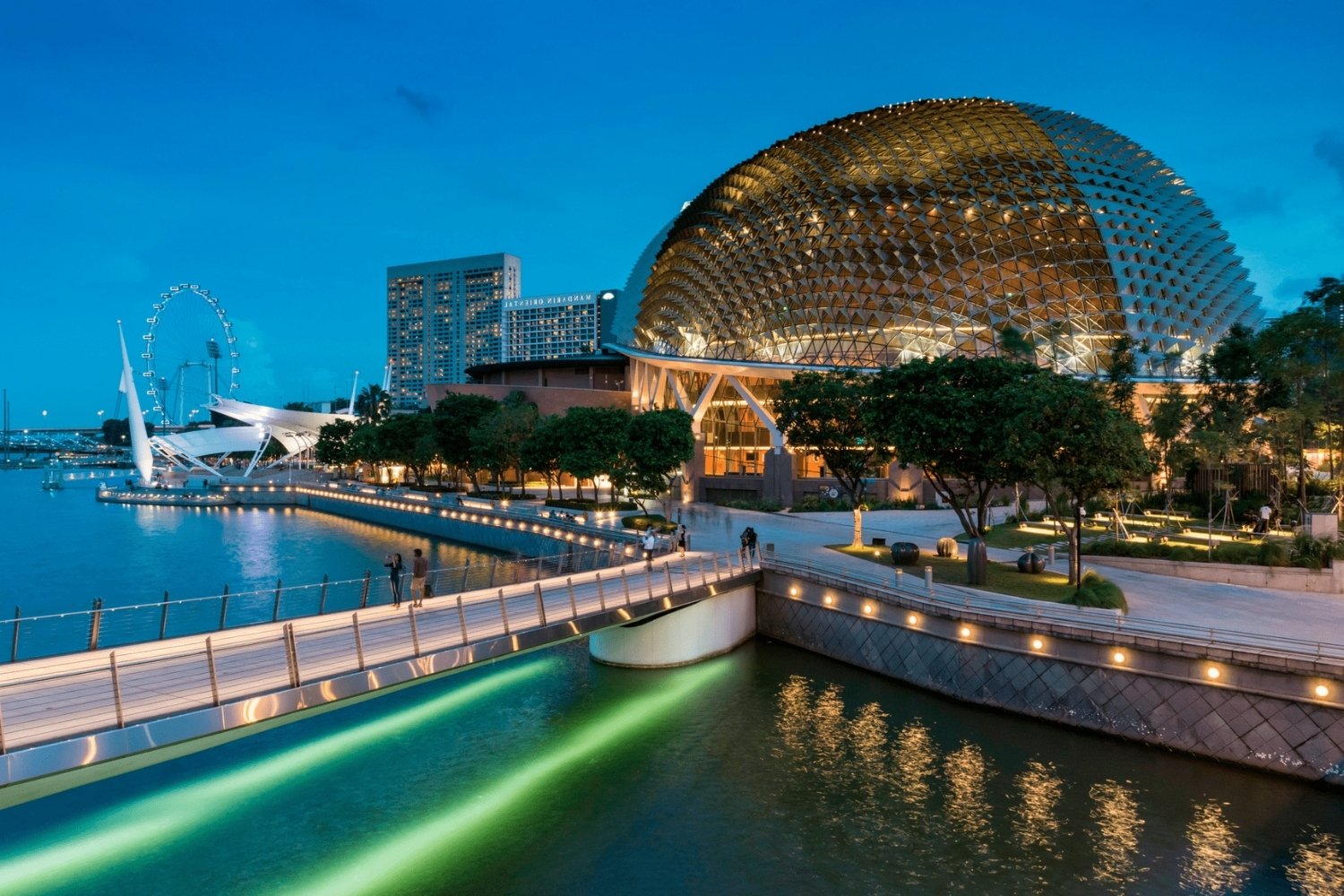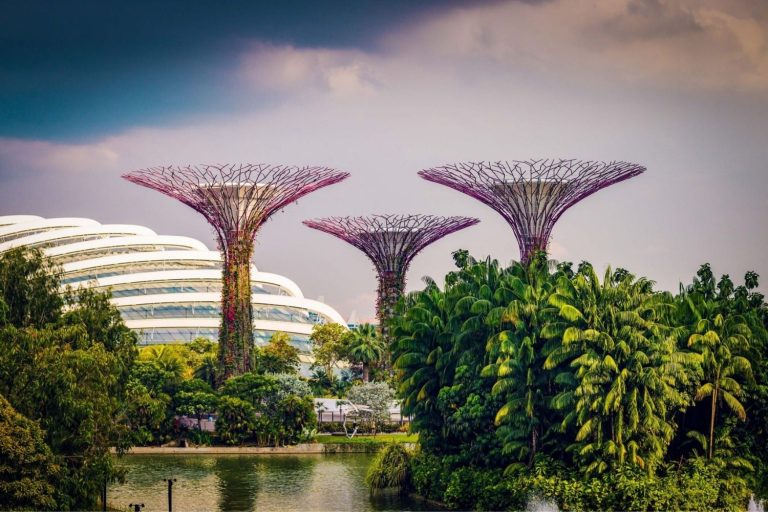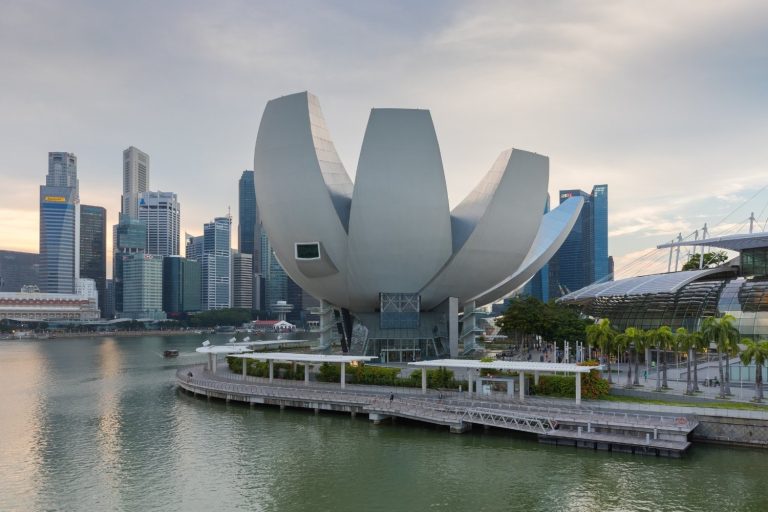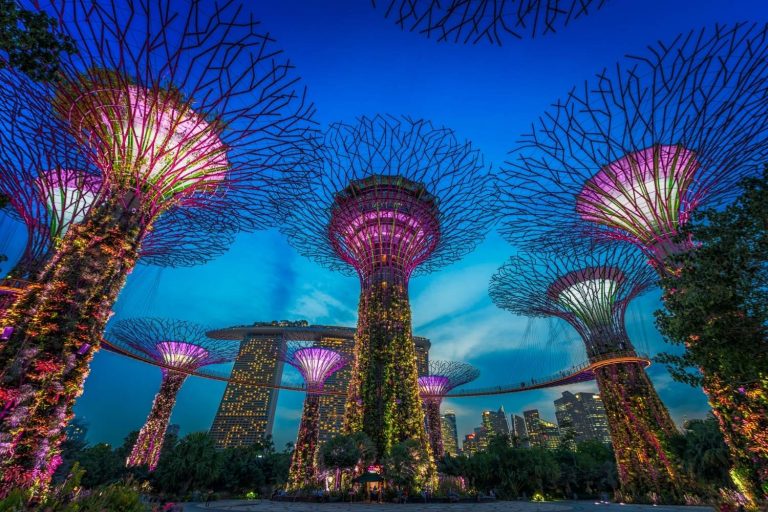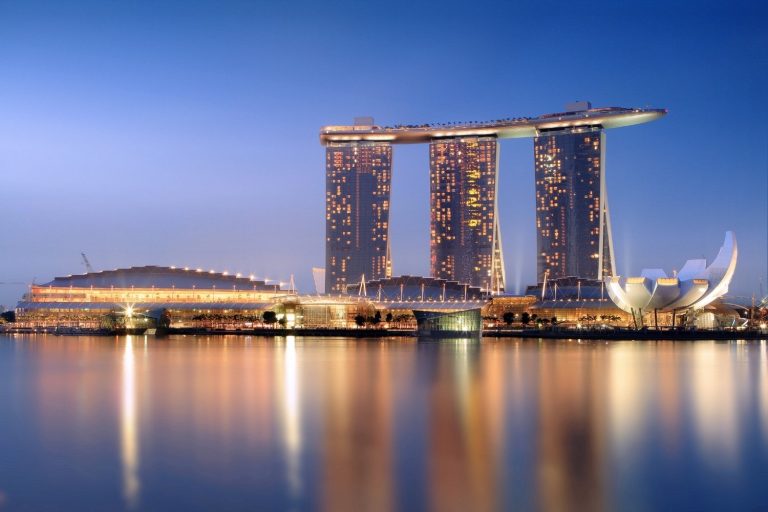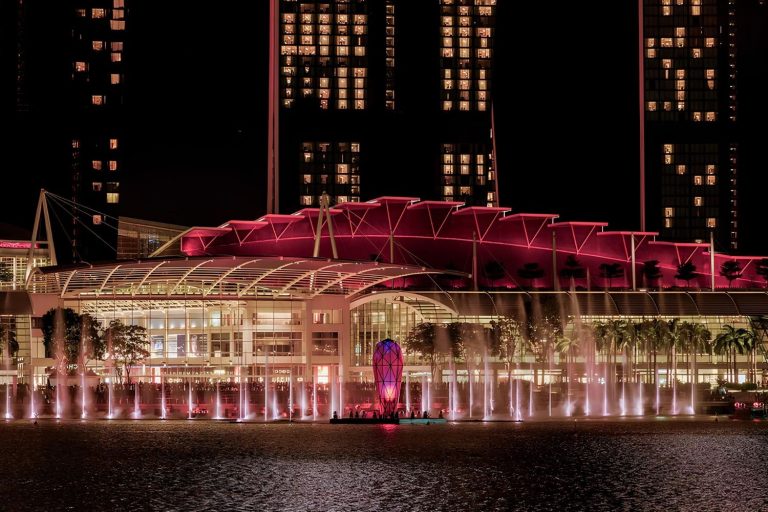Esplanade – Theatres on the Bay: Durian-shaped Arts Centre
The Heart of Singapore’s Cultural Scene
Singapore’s Esplanade – Theatres on the Bay stands as one of the most recognizable landmarks along the Marina Bay waterfront. This world-class performing arts centre has become synonymous with Singapore’s cultural identity since opening its doors in 2002. Built on reclaimed land near the historic Esplanade Park, this architectural marvel serves as the nation’s premier venue for music, dance, theatre, and visual arts.
The arts centre’s distinctive appearance has earned it the affectionate nickname of the ‘durian’ among locals and visitors alike. This comparison to Southeast Asia’s beloved yet polarizing fruit stems from the building’s unique exterior design featuring thorny aluminum spikes that create dramatic patterns across its twin domes. What began as a practical solution for climate control has evolved into an iconic symbol that represents Singapore’s bold approach to contemporary architecture and cultural development.
Overview of the Arts Centre
The Esplanade complex houses multiple performance venues, including a 1,600-seat Concert Hall and a 2,000-seat Theatre, along with smaller recital studios and rehearsal spaces. These facilities host over 3,000 performances annually, ranging from intimate chamber music concerts to large-scale Broadway productions. The centre’s commitment to showcasing both international and local talent has made it a cultural bridge connecting Singapore to the global arts community while nurturing homegrown artistic expression.
Significance of the Durian-Shaped Design
The building’s controversial yet beloved design reflects Singapore’s willingness to embrace bold architectural statements. Initially met with mixed reactions from the public, the durian-inspired exterior has since become a source of national pride. The thorny facade serves multiple purposes beyond aesthetics, providing essential sun shading and climate control in Singapore’s tropical environment. This functional beauty demonstrates how innovative design can address practical challenges while creating memorable landmarks.
Location and Accessibility
Strategically positioned along Marina Bay, the Esplanade enjoys proximity to other major attractions including the Marina Bay Sands integrated resort and the stunning Gardens by the Bay conservatories. This prime location makes it easily accessible via multiple transportation options, including MRT stations, bus routes, and waterfront walkways. The centre’s position within Singapore’s cultural district allows visitors to explore multiple attractions in a single visit, creating a comprehensive cultural experience.
Community Engagement Initiatives
Beyond hosting performances, the Esplanade actively engages with local communities through educational programs, workshops, and outreach initiatives. The centre’s commitment to making arts accessible to all Singaporeans includes subsidized tickets, free outdoor performances, and specialized programs for seniors and students. These efforts ensure that the arts remain an integral part of community life rather than an exclusive privilege for the affluent.
A Calendar Packed with Cultural Experiences
The Esplanade’s programming calendar reflects Singapore’s position as a global cultural hub, featuring an eclectic mix of traditional and contemporary performances. The venue’s diverse offerings cater to varied tastes and age groups, ensuring that every visit provides new discoveries and experiences. From world-renowned orchestras to emerging local artists, the programming demonstrates the centre’s commitment to artistic excellence and cultural diversity.
The arts centre’s approach to programming emphasizes both accessibility and quality, with many events designed to introduce newcomers to different art forms while satisfying seasoned arts enthusiasts. This balanced programming strategy has helped cultivate Singapore’s growing arts audience and established the Esplanade as an essential cultural destination.
Mosaic Music Series 2025-26
The flagship Mosaic Music Series continues to showcase the rich tapestry of Asian musical traditions alongside contemporary innovations. This annual series features collaborations between traditional musicians and modern artists, creating unique fusion performances that celebrate cultural heritage while pushing artistic boundaries. The 2025-26 edition promises to feature artists from across the region, highlighting the diverse musical landscapes that define contemporary Asian culture.
da:ns focus Dance Series
Dance enthusiasts can look forward to the da:ns focus series, which presents cutting-edge choreography from both established and emerging dance companies. This series emphasizes contemporary dance while respecting traditional movement forms, creating a platform for artistic dialogue between different dance cultures. The programming includes workshops and masterclasses, allowing audiences to engage more deeply with the art form.
Exhibitions ‘Only the Wind Remembers’ & ‘Manners Manners Quek’
The visual arts component of the Esplanade’s programming includes thought-provoking exhibitions that explore themes relevant to contemporary Southeast Asian society. ‘Only the Wind Remembers’ examines collective memory and cultural preservation, while ‘Manners Manners Quek’ investigates social conventions and behavioral patterns in modern urban environments. These exhibitions demonstrate the centre’s commitment to presenting art that engages with current social and cultural issues.
Family-Friendly Activities
Recognizing the importance of nurturing young arts audiences, the Esplanade offers numerous family-oriented programs throughout the year. These activities include interactive performances, hands-on workshops, and educational tours designed to make arts experiences accessible and enjoyable for children. The centre’s family programming often incorporates elements of play and discovery, helping to develop lifelong appreciation for the arts.
Virtual Tours and Offsite Performances
Embracing technological innovation, the Esplanade has expanded its reach through virtual tours and digital performances. These initiatives allow people who cannot physically visit the centre to experience its offerings, while offsite performances bring arts directly to communities across Singapore. This hybrid approach to programming demonstrates the centre’s adaptability and commitment to reaching diverse audiences.
Architectural Marvel of Marina Bay
The Esplanade’s architecture represents a successful marriage of form and function, addressing Singapore’s unique climatic challenges while creating spaces that inspire artistic excellence. The building’s design process involved extensive collaboration between architects, engineers, and acousticians to ensure that aesthetic ambitions did not compromise performance quality. This holistic approach to design has resulted in a structure that serves as both an architectural landmark and a world-class performance venue.
The building’s integration with its waterfront setting creates seamless connections between indoor and outdoor spaces, allowing the arts centre to extend its programming beyond traditional theatre walls. This relationship with the surrounding environment, including views of the Marina Bay Sands skypark and the iconic Singapore Flyer observation wheel, enhances the overall cultural experience for visitors.
Design Evolution from Lantern to Durian
The architectural journey from initial concept to final construction reveals fascinating insights into the creative process. Early designs explored various metaphors, including lantern and flower shapes, before settling on the current form. This evolution reflects the collaborative nature of architectural development and the importance of responding to both practical requirements and cultural context in creating meaningful public spaces.
Exterior Features Thorny Domes and Sunshade Spikes
The building’s most distinctive feature consists of approximately 7,000 aluminum sunshade spikes arranged in geometric patterns across the twin domes. These elements serve as both architectural ornament and functional climate control system, reducing solar heat gain while creating dramatic shadow patterns that change throughout the day. The spikes’ triangular shape and metallic finish create a dynamic exterior that responds to Singapore’s intense tropical light conditions.
Sustainability Initiatives and Green Certifications
Environmental responsibility plays a crucial role in the Esplanade’s operations, with the centre earning the BCA Green Mark Platinum Award in 2018. This recognition acknowledges comprehensive sustainability measures including energy-efficient LED lighting systems, rainwater collection infrastructure, and waste reduction programs. These initiatives demonstrate that cultural institutions can lead by example in environmental stewardship while maintaining operational excellence.
Interior Acoustics of the Concert Hall
The Concert Hall’s acoustic design represents one of the building’s greatest technical achievements, featuring adjustable reverberation systems that can accommodate both Asian and Western musical traditions. The hall’s warm timber interior creates an intimate atmosphere despite its substantial capacity, while sophisticated sound engineering ensures optimal listening conditions from every seat. This acoustic flexibility allows the venue to host everything from traditional gamelan performances to full symphony orchestras with equal success.
Cultural Impact and Community Connection
The Esplanade’s influence extends far beyond its role as a performance venue, serving as a catalyst for Singapore’s broader cultural development. The centre’s programming philosophy emphasizes inclusivity and accessibility, working to break down barriers that might prevent people from engaging with the arts. This approach has helped cultivate a more diverse and engaged arts audience while supporting the growth of Singapore’s creative industries.
Through partnerships with schools, community organizations, and cultural institutions, the Esplanade has become deeply embedded in Singapore’s social fabric. These relationships ensure that the centre remains relevant to local communities while maintaining its international profile and artistic standards.
Role in Promoting Arts and Culture
As Singapore’s national performing arts centre, the Esplanade carries significant responsibility for advancing the country’s cultural agenda. The venue’s programming decisions influence public perceptions of different art forms while its educational initiatives help develop cultural literacy across all segments of society. This leadership role requires careful balance between artistic excellence and public accessibility, a challenge the centre has navigated successfully since its opening.
Support for Local Artists
The centre’s commitment to nurturing local talent includes residency programs, commissioning opportunities, and mentorship initiatives that help Singapore artists develop their careers. These programs provide crucial support for emerging artists while ensuring that local voices remain prominent in the centre’s programming. The investment in homegrown talent has contributed to the flourishing of Singapore’s arts scene and helped establish the city-state as a regional cultural hub.
Community Programs and Memberships
Membership programs and community initiatives make the arts more accessible while building lasting relationships between the centre and its audiences. These programs include discounted tickets, priority booking, and exclusive events that reward regular supporters. The centre also offers specialized programs for seniors, students, and families, ensuring that cost does not become a barrier to arts participation.
Environmental Leadership in the Arts
The Esplanade’s environmental initiatives demonstrate how cultural institutions can contribute to sustainability goals while maintaining operational excellence. The centre’s comprehensive approach to environmental management includes both technological solutions and behavioral changes that reduce its overall ecological footprint. These efforts serve as a model for other cultural institutions seeking to balance artistic ambitions with environmental responsibility.
The integration of sustainable practices into daily operations shows that environmental consciousness and artistic excellence can coexist successfully. This approach has helped establish the Esplanade as a leader in sustainable arts management while contributing to Singapore’s broader environmental goals.
Rainwater Collection Systems
Sophisticated rainwater harvesting systems capture and store precipitation for use in landscaping and cleaning operations. This infrastructure reduces reliance on treated water while managing stormwater runoff in Singapore’s urban environment. The system’s integration into the building’s design demonstrates how environmental considerations can be seamlessly incorporated into architectural planning without compromising aesthetic goals.
Energy Efficiency in Operations
Comprehensive energy management systems monitor and optimize power consumption throughout the facility, with LED lighting and smart building controls reducing overall energy demand. These systems automatically adjust lighting and climate control based on occupancy and usage patterns, ensuring optimal comfort while minimizing waste. The centre’s energy efficiency measures have resulted in significant cost savings while reducing environmental impact.
Waste Management Practices
The centre’s waste reduction programs include recycling initiatives, composting systems, and partnerships with local organizations that repurpose materials from productions and events. These efforts divert significant amounts of waste from landfills while creating opportunities for community engagement around environmental issues. Staff training and visitor education programs help extend these practices beyond the centre’s walls.
Collaboration with Environmental Agencies
Partnerships with government agencies and environmental organizations help the Esplanade stay current with best practices while contributing to broader sustainability research. These collaborations include participation in pilot programs, data sharing for environmental studies, and joint initiatives that promote sustainability in the arts sector. Such partnerships demonstrate the centre’s commitment to continuous improvement in environmental performance.
Welcoming All Visitors
The Esplanade’s commitment to accessibility ensures that all members of the community can participate in arts experiences regardless of physical abilities or economic circumstances. This inclusive approach requires ongoing investment in both physical infrastructure and programmatic initiatives that remove barriers to participation. The centre’s accessibility efforts serve as a model for other cultural institutions while demonstrating that inclusivity enhances rather than compromises artistic excellence.
Visitor feedback systems and regular accessibility audits help the centre identify areas for improvement while ensuring that accessibility measures meet the evolving needs of the community. This responsive approach to accessibility management shows that inclusion is an ongoing process rather than a one-time achievement.
Accessibility Features for All Visitors
Comprehensive accessibility features include wheelchair-accessible entrances, assistive listening systems, and sensory-friendly performance options that accommodate visitors with different needs. These features are integrated into the building’s design rather than added as afterthoughts, creating seamless experiences for all visitors. Staff training ensures that accessibility features are properly maintained and that visitors receive appropriate assistance when needed.
Visitor Engagement and Feedback
Regular surveys and feedback collection help the centre understand visitor experiences and identify opportunities for improvement. This information guides programming decisions, facility upgrades, and service enhancements that better serve the community’s needs. The centre’s responsiveness to feedback demonstrates its commitment to continuous improvement and visitor satisfaction.
Guided Tours and Facilities
Behind-the-scenes tours provide insights into the centre’s operations while highlighting architectural and technical features that might otherwise go unnoticed. These tours include visits to backstage areas, technical facilities, and rehearsal spaces that give visitors a comprehensive understanding of how the centre functions. Knowledgeable guides share stories about the building’s history, design process, and notable performances that have taken place on its stages.
Singapore’s Cultural Cornerstone
The Esplanade’s position within Singapore’s cultural landscape extends beyond its role as a performance venue to encompass broader responsibilities for arts education, cultural preservation, and international cultural exchange. The centre’s influence on Singapore’s cultural development can be measured not only in attendance figures and performance quality but also in its contribution to the city-state’s reputation as a regional cultural hub.
Collaborations with other cultural institutions create synergies that benefit the entire arts ecosystem while partnerships with educational institutions help develop the next generation of arts professionals and audiences. These relationships demonstrate the interconnected nature of cultural development and the importance of institutional cooperation in building vibrant arts communities.
Integration with Other Cultural Institutions
Strategic partnerships with museums, galleries, and other cultural venues create comprehensive cultural experiences that encourage visitors to explore multiple institutions. These collaborations might include joint programming, shared marketing initiatives, or coordinated exhibitions that tell larger cultural stories. The proximity to attractions like the ArtScience Museum and the Red Dot Design Museum creates natural opportunities for cultural tourism that benefits all participating institutions.
Promoting Arts Education and Literacy
Educational programs targeting students, teachers, and lifelong learners help develop cultural literacy and appreciation for different art forms. These initiatives include curriculum-linked programs for schools, professional development for educators, and public lectures that make arts knowledge accessible to general audiences. The centre’s educational role extends beyond its own programming to support broader cultural education goals across Singapore.
Visitor Statistics and Trends
Analysis of visitor data reveals trends in arts participation and helps guide future programming decisions. This information shows growing diversity in audiences and increasing interest in Asian arts and contemporary performances. The data also demonstrates the centre’s success in attracting both local and international visitors, contributing to Singapore’s tourism industry while serving local cultural needs.
Looking Ahead Cultural Innovation
The Esplanade’s future development plans reflect both changing audience expectations and evolving artistic practices. These initiatives include technological innovations that enhance performance experiences, new programming formats that reach different demographics, and facility upgrades that improve accessibility and sustainability. The centre’s forward-looking approach ensures its continued relevance in Singapore’s rapidly evolving cultural landscape.
Long-term planning considers both artistic and operational sustainability, balancing ambitious programming goals with financial responsibility and environmental stewardship. This comprehensive approach to institutional development provides a foundation for continued growth and innovation while maintaining the centre’s core mission of making excellent arts accessible to all.
New Programs and Events Planned
Upcoming programming initiatives include expanded digital offerings, community-based performances, and collaborative projects with regional cultural institutions. These programs reflect changing audience preferences while maintaining the centre’s commitment to artistic excellence. New formats such as immersive performances and interactive exhibitions demonstrate the centre’s willingness to experiment with different ways of engaging audiences.
Innovations in Arts and Technology
Technological integration enhances both artistic possibilities and operational efficiency, with new systems supporting everything from advanced lighting design to audience engagement platforms. These innovations allow artists to explore new creative territories while providing audiences with richer, more interactive experiences. The centre’s investment in technology demonstrates its commitment to staying at the forefront of arts presentation and audience engagement.
Long-term Vision for Esplanade
The centre’s strategic vision emphasizes continued growth in artistic quality, audience development, and community engagement while maintaining its distinctive character and mission. This vision includes plans for facility enhancements, programming expansion, and deeper integration with Singapore’s broader cultural and educational institutions. The long-term perspective ensures that the Esplanade will continue serving as Singapore’s cultural flagship while adapting to changing needs and opportunities.
Frequently Asked Questions
What is the Esplanade – Theatres on the Bay?
The Esplanade – Theatres on the Bay is a major performing arts center in Singapore, known for its distinctive durian-shaped design and diverse programming.
What types of performances does the Esplanade host?
The Esplanade hosts a wide range of performances, including music, dance, theatre, and visual arts, featuring both local and international artists.
How does the Esplanade engage with the community?
The Esplanade engages with the community through educational programs, workshops, subsidized tickets, and free outdoor performances.
What sustainability initiatives does the Esplanade have?
The Esplanade implements various sustainability initiatives, including rainwater collection systems, energy-efficient operations, and waste management practices.
How can visitors access the Esplanade?
The Esplanade is located along Marina Bay and is accessible via MRT stations, bus routes, and waterfront walkways.
The Heartbeat of Singapore’s Arts Scene
As a cornerstone of Singapore’s cultural identity, the Esplanade – Theatres on the Bay not only showcases exceptional performances but also fosters community involvement and sustainability. Its innovative design and diverse programming reflect the nation’s commitment to the arts, ensuring that it remains a vital and accessible hub for creativity and cultural exchange.
